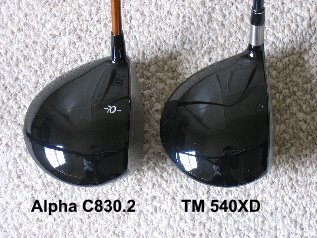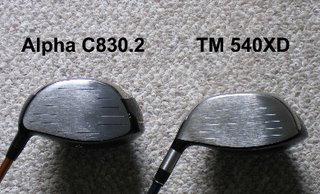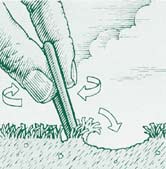The UPS delivery guy is the Santa Claus for adults. I always get that sudden rush of excitement when I see that plain brown cardboard box sitting on my doorstep. Such was the feeling when I recently found a long, skinny box perched against my front door. Inside was an Alpha C830.2 driver with an Aldila NVS shaft!
You may be wondering,
what the heck is an Alpha C830.2? We are all familiar with the big golf club companies such as Titleist, Ping, TaylorMade, etc. These guys have huge marketing budgets to ensure that they remain top of mind with the consumer. As a result, it's very difficult for the new and smaller golf companies to get noticed.
Alpha Golf is one such golf company. Started in 2000, Alpha was able to attract some attention relatively quickly by making a name for themselves in the sport of professional long drive. Long drive is golf's loud, rebellious and juiced-up younger brother. It is a sport that takes one element of golf to the max and then kicks it up a notch. To be successful, competitors need equipment that can withstand extreme conditions.
Alpha Golf recognized this need and developed drivers that could take the punishment while still offering top performance. Alpha's success on the Long Drivers of America (LDA) circuit speaks for itself. But how would such a specialized driver work for the average golfer?
That's what I wanted to find out with Alpha's C830.2. I had read that the driver head was a full 460cc, so when I opened the package I fully expected to see a Yugo on a stick.

However, I was surprised to find a rather conventional looking driver in terms of size. In fact, it looks even smaller than my 400cc TaylorMade 540XD when viewed from the top! At first I thought that I had received the wrong driver, but "460cc" was clearly stamped into the sole.
Like Anna Nicole Smith, the Alpha C830.2 hides its mass well.
I was anxious to get to the course to see how the Alpha C830.2 would stack up. To be honest, I haven't hit many 460cc drivers. They always appeared a little too big for my liking. In this respect, the C830.2 was easy on my eyes.
I have been playing with the C830.2 exclusively over the last month and I can honestly say that I'm pleasantly surprised.

With my trusty ol' TaylorMade 540XD, I probably drive the ball an average of 260-270 yards when I nut it. It's hard to say for sure, but it seems that I'm a little longer with the C830.2. I just don't know if it's the sword or the swordsman. I could be subconsciously swinging harder than normal because I know that the C830.2 is a "long drive" driver. Regardless, I've hit some of my longest drives ever on my home course with the C830.2.
In terms of accuracy, the C830.2 fares well. With 460cc, it better! With all that surface area from its deep face, I seem to hit the screws on the C830.2 more frequently than my 540XD. As a result, my drives are a little bit more accurate.
As far as feel goes, I would characterize the C830.2 as having a solid metallic feel and sound, reminiscent of a Titleist driver. It doesn't have that hollow aluminum baseball bat sound found on some of the other 460cc drivers.
Having put the C830.2 through its paces, I believe that it compares very favorably against the "Big Name" offerings. Whether it is the right driver for you is another question.
I feel that golfers need to demo many different drivers to find one that best fits their individual game. That being said, the C830.2 is definitely worth a swing. It may be especially attractive to those traditionalists who are uncomfortable looking down at some of the gigantic looking 460cc drivers out there. Just don't fall into the trap of assuming that the C830.2 is a "long drivers only" club. It works great for the "average" player as well.



















